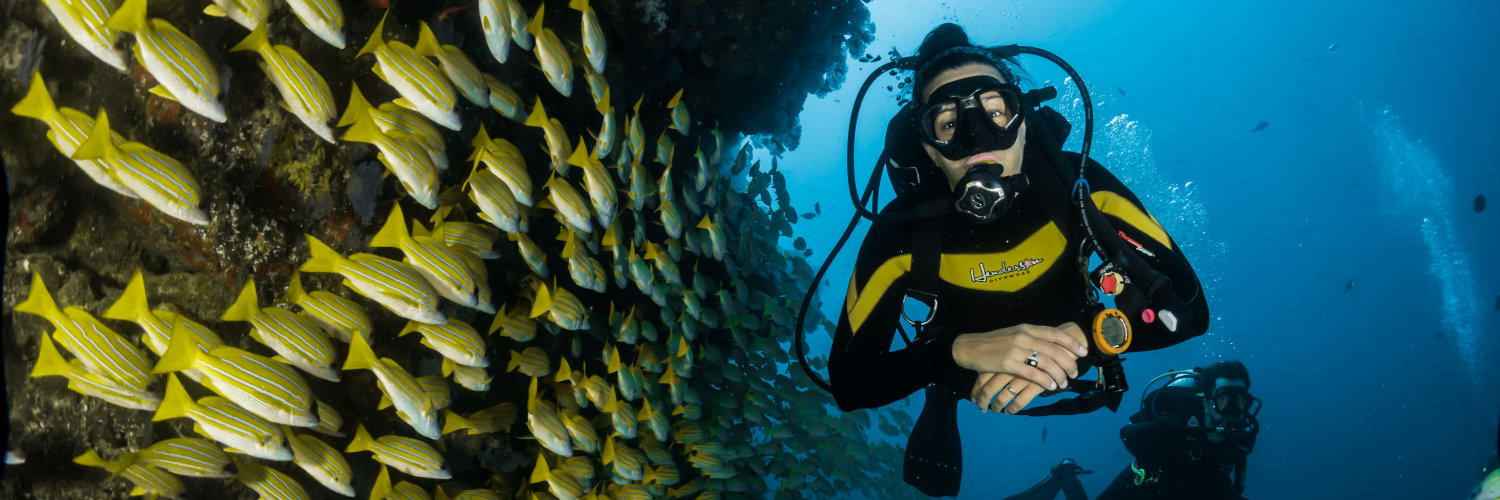A scuba surface marker buoy, commonly referred to as an SMB, is an essential safety device for divers operating in open water. It serves as a signaling tool to alert boats and other vessels to the presence of divers below. The SMB is typically a bright, inflatable tube that, once deployed, stands upright on the water’s surface, providing a highly visible marker. Its use is crucial in areas with high boat traffic, where it enhances diver safety by marking the diver’s position to those at the surface.
SMBs come in various sizes and styles, with features to suit different diving situations. The most common colors are red or orange, as they offer a stark contrast against the blues and greens of the ocean. Some SMBs are equipped with reflective tape or a pouch for a light, which enhances visibility in low-light conditions or during night dives. Additionally, certain models include a D-ring for attaching safety stop lines or a reel with a line to help manage the distance between the buoy and the diver.
The deployment of an SMB is a learned skill that forms part of dive training programs. Knowing how to properly use an SMB is important for every diver to ensure their own safety and the safety of their group when diving in open water. With the right surface marker buoy, divers can significantly reduce the risks associated with boat traffic and enhance their visibility to surface support teams.
Basics of Surface Marker Buoys
Surface marker buoys (SMBs) are critical safety devices for scuba divers, signifying positions and aiding in dive operations. They come in various types, each with specific features and uses to enhance diver safety.
Purpose and Importance
SMBs are employed by divers to mark their position to those on the surface. Visibility is a pivotal concern in the design of these buoys, as they are meant to be easily seen in a range of light conditions. The use of reflective tape and high-contrast colors like red or orange are standard. In emergency situations, a yellow SMB may be deployed, signaling the need for immediate attention. They serve not only as a safety signal for boat traffic, avoiding collisions, but also as a reference for divers during ascent or when making safety stops.
Types of SMBs
There are multiple forms of SMBs, tailored for different diving scenarios:
- Closed SMB: This type is a sealed buoy that remains inflated once deployed, offering continual surface visibility throughout the dive.
- DSMB (Delayed Surface Marker Buoy): Typically deployed underwater at the end of the dive, or during a safety stop. It is a preferred method to communicate diver’s ascent position to surface personnel or vessels.
Diver SMBs come in various sizes to suit the dive environment and personal preferences, with some models reaching lengths of 175cm for increased visual footprint. Material durability, compactness for ease of transportation, and reliable deployment mechanisms are quintessential characteristics evaluated when choosing the right SMB for diving activities. Common features among different types of SMBs include attachments like stainless steel D-rings for safety stop lines and dive lights, contributing to the overall functionality and safety purpose of these devices.
Visibility and Material Considerations
In scuba diving, the visibility of surface marker buoys (SMBs) is critical for safety, while the material determines their durability and functionality.
Choosing the Right Color
The color of an SMB is vital for its visibility and hence the diver’s safety. Standard colors for SMBs are red and orange, as they stand out against the blue and green tones of the ocean. A diver should choose SMBs with high-contrast colors to ensure they are easily seen from a distance by boaters, fellow divers, and rescue teams.
- Red: Universal signal for diver’s presence underwater
- Orange: Offers high visibility in most water conditions
Some SMBs use yellow to signify emergencies, alerting others that the diver needs immediate assistance.
Material and Durability
The material of an SMB affects its longevity and performance in challenging conditions. Durable materials such as polyurethane-coated nylon resist abrasion and can withstand the pressure of deep water without tearing. Furthermore, aspects like a stainless steel D-ring add to the SMB’s functionality, allowing divers to attach safety stop lines and lights.
For enhanced visibility:
- Reflective tape: Used especially at the top of the buoy, it can catch sunlight or torchlight, making it visible in low light conditions and during nighttime. It is a common feature in robust SMBs.
SMBs must be both seen and sturdy to be effective. When selecting an SMB, divers should prioritize features that ensure the buoy is clearly visible and can endure the underwater environment.
Deployment Techniques
Deploying a surface marker buoy (SMB) is an essential skill for divers, enhancing safety by signaling their position to those at the surface. This section will focus on the methods used to inflate the SMB and the use of reels and spools during deployment.
Inflation Methods
There are two primary methods divers use to inflate a Surface Marker Buoy: using a low-pressure inflator or oral inflation.
Low-pressure inflator: Divers can connect the low-pressure hose from their regulator to the SMB’s inflation valve. This method allows for rapid and effortless inflation, which is crucial in situations where a quick ascent is necessary.
- Pros:
- Fast and efficient
- Requires less effort
- Cons:
- Dependence on remaining air supply
- Potential for overinflation if not managed carefully
- Pros:
Oral inflation: For this method, divers exhale into the oral inflation valve to fill the buoy. Oral inflation demands more effort and time but can be useful if the diver’s air supply is low or if they prefer more control over the inflation process.
- Pros:
- Doesn’t depend on air supply from the tank
- Offers greater control over the amount of air used
- Cons:
- More time-consuming
- May be challenging in rough conditions
- Pros:
Using Reels and Spools
The deployment of an SMB typically involves the use of a reel or spool to manage the line as the buoy ascends to the surface.
Reels: These are equipped with a handle and a mechanical system to wind the line. They are ideal for deeper dives or situations where precise control over the buoy’s ascent is necessary.
- Pros:
- Good for deep deployments
- Easy line management with the winding mechanism
- Cons:
- Bulkier to carry
- More complex to use
- Pros:
Spools: Spools are simpler devices that consist of a round piece of plastic or metal with a line wrapped around it. They are smaller and lighter, making them convenient for shallower dives or minimalistic dive gear setups.
- Pros:
- Light and easy to carry
- Simple, with fewer moving parts
- Cons:
- Requires manual line management
- Can become entangled if not handled properly
- Pros:
Both devices are critical during the safety stop, as they enable the SMB to signal the diver’s position while allowing the diver to maintain their depth and control over the ascent. Maintaining tension on the line is key to keeping the SMB upright and visible at the surface.
Safety Procedures and Emergency Use
In scuba diving, safety procedures for effective use of a surface marker buoy (SMB) are critical to prevent emergencies and ensure a diver’s location is clearly marked. These procedures include measures to avoid entanglement and ways to utilize an SMB for emergency signaling.
Avoiding Entanglement
Safety Tip: Always deploy your SMB in an area clear of obstructions.
- Pre-deployment check: Prior to inflating the SMB, a diver must ensure no loose gear or lines could cause entanglement.
- Controlled Inflation: Inflating the SMB should be done with care to prevent the line from tangling. Keeping tension on the line as the SMB ascends can mitigate this risk.
- Awareness: Constant awareness of one’s surroundings and boat traffic can prevent lines from becoming hazards.
Emergency Signaling and Location Marking
Emergency Use: An SMB can serve as a critical emergency signal to boats or a surface team that a diver requires assistance.
- Color Coding: Certain colors such as orange or yellow are commonly used for visibility and to signify non-emergency location marking. In contrast, red or similar colors might be pre-arranged to indicate distress.
- Night or Low Light: Reflective tape or attaching a light to the SMB enhances visibility and aids rapid location identification by rescue teams or boats.
By adhering to these safety procedures, divers can use SMBs effectively to signal and mark their location in both standard and emergency situations, thereby minimizing the risks associated with boat traffic and underwater entanglement hazards.
Integration with Dive Equipment
Integrating a surface marker buoy (SMB) with a diver’s equipment is essential for safety and efficiency. Proper attachment and streamlined storage are the cornerstones of effective SMB use during a dive.
Attachment and Inflation
BCD (Buoyancy Control Device): Divers typically attach the SMB to the D-ring on their BCD to keep it within reach. The BCD’s low-pressure inflator can also provide an efficient means of inflating the SMB via a direct connection.
Attachment Process:
- Secure the SMB to a BCD via stainless steel D-rings.
- Ensure the D-ring is easily accessible.
Inflation Mechanism:
- Use the BCD’s low-pressure inflator to fill the SMB.
- Some SMBs may be inflated by purging air from the regulator into the open end or using the mouth.
Inflating the SMB should be a simple process. Divers can use the low-pressure inflator for quick inflation or, alternatively, inflate the buoy manually using their regulator or mouth.
Storing SMBs During Dives
Proper storage ensures SMBs are readily available and do not interfere with the diver’s mobility.
- Storage Considerations:
- Compact and secure positioning on the dive gear.
- Easy deployment to prevent entanglement.
SMBs should be folded or rolled tightly and then stowed in a pocket on the diver’s BCD or attached to a D-ring where they can be easily deployed. It is important that the SMB does not dangle loosely, as this may catch on underwater obstacles or impede swimming. The storage method should also protect the SMB from accidental deployment.
Advanced Considerations for Technical Scuba Diving
In technical scuba diving, where decompression and varying dive conditions present unique challenges, effective use of surface marker buoys (SMBs) is critical for maintaining diver safety and communication with the surface.
Decompression and Deep Dives
Technical divers conducting deep and decompression dives must employ SMBs as a vital part of their safety protocol. During these dives:
Decompression Stops: They use SMBs to mark their position in the water column during required decompression stops. Each decompression stop, normally conducted at predetermined depths, helps divers avoid decompression illness by allowing nitrogen to safely off-gas from their bodies.
Visibility at Depth: High-visibility SMBs are crucial in clear signaling of the diver’s location to the support team above water, particularly important in scenarios where divers cannot ascend immediately due to decompression obligations.
Redundancy: Carrying a backup SMB and reel or spool is a standard practice, ensuring that technical divers can still signal if the primary SMB fails.
Using SMBs in Specific Dive Conditions
The deployment and type of SMB technical divers choose can vary based on dive conditions such as currents or visibility:
Drift Dives: In strong current conditions, divers might opt for a drift dive SMB deployment. This means the SMB is used from the beginning of the dive to continually mark the divers' locations as they drift with the current, ensuring boat support can follow.
Low Visibility: In low visibility conditions, SMBs with reflective tape or built-in lights can enhance detection from the surface, addressing safety concerns where traditional visual signals might not suffice.
Complex Environments: In caves or wreck penetrations, where divers might resurface at a different location from their entry point, strategically placed SMBs can assist them in navigating back to the exit point or serve as a reference for support teams.





